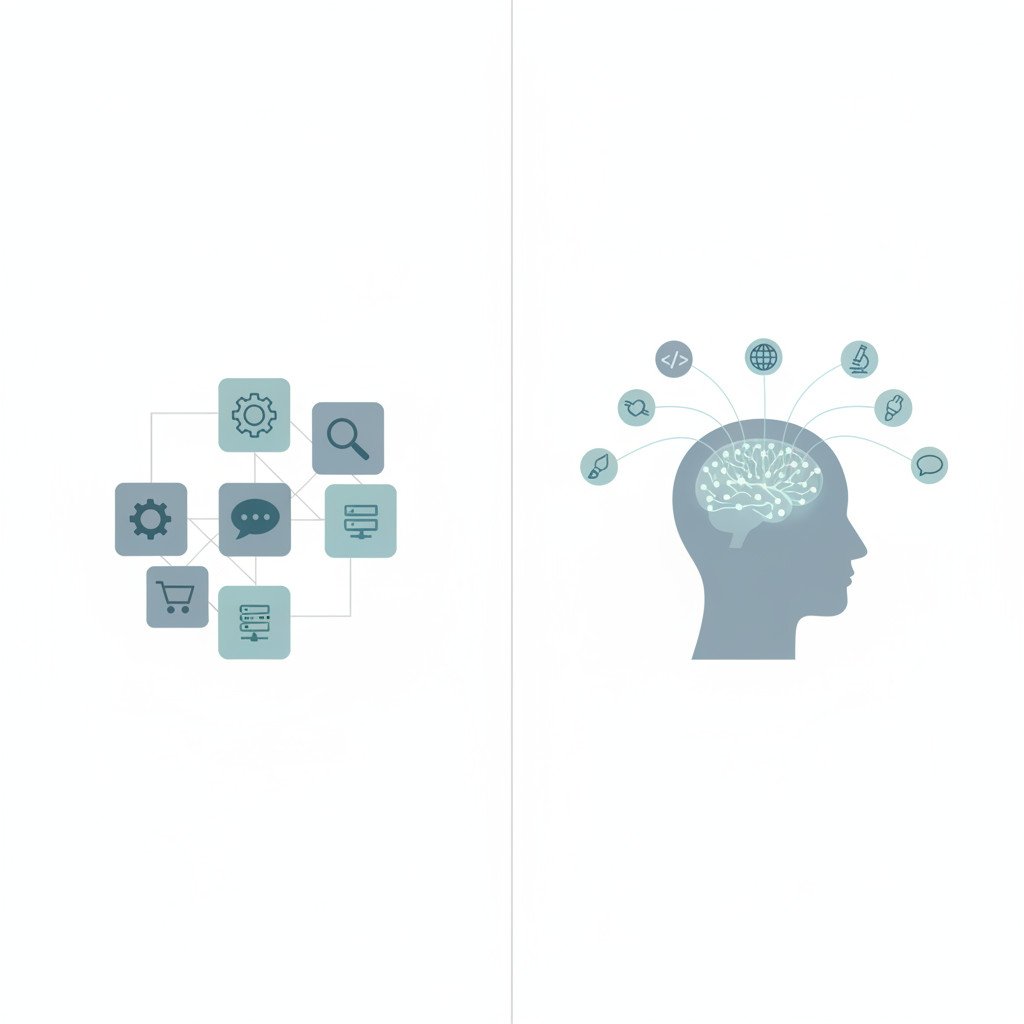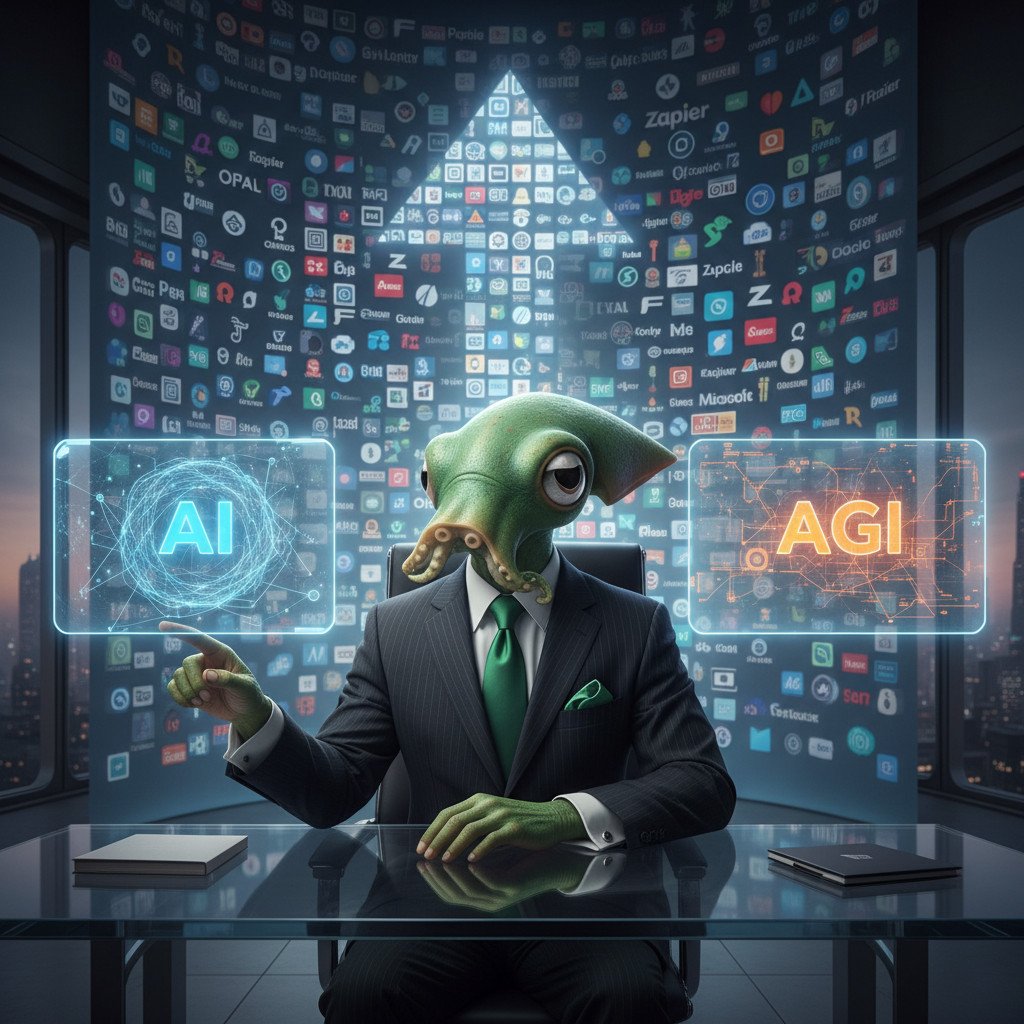AGI vs AI is more than a buzz phrase; it frames how leaders plan technology and risk. AI, or artificial intelligence, refers to systems built for narrow tasks. They recommend videos, draft emails, and search results. AGI, or artificial general intelligence, refers to a machine with human-level, domain-general understanding. It could learn and apply knowledge across any intellectual task. Today, most tools are narrow AI, not AGI. However, misunderstanding this gap can skew strategy and budgets. Therefore business decision-makers must know the limits and the possibilities of each.
Because AI already automates workflows across thousands of apps, leaders should focus on integration, safety, and measurable outcomes. Yet watching progress toward AGI matters too, because its arrival would reshape work, regulation, and value creation. So how should you balance investment in current AI tools with planning for a possible AGI future? This guide explains clear differences, practical steps, and strategic questions to help you lead with clarity.
What is Artificial Intelligence?
Artificial intelligence, or AI, describes systems that perform tasks requiring human-like intelligence. In practice, most systems today use narrow AI. Narrow AI solves specific problems like recommending videos and drafting emails. Machine learning powers many of these systems, because models learn patterns from data. Therefore AI today focuses on accuracy, speed, and automation rather than general reasoning.
Core technologies behind AI
- Machine learning: Algorithms that learn from data and improve over time.
- Deep learning: Neural networks that extract complex patterns from large datasets.
- Natural language processing: Tools that read, write, and summarize text.
- Computer vision: Systems that interpret images and video.
- Reinforcement learning: Agents that learn by trial and error.
- Automation platforms: No-code tools that combine AI with workflows for scale.
Common business applications today
- Search and recommendations: AI ranks results and suggests content.
- Content drafting and summarization: AI drafts emails, reports, and briefs. For more on integrating AI into workflows, see Zapier vs Gumloop: How Do You Choose the Right AI-First Automation for Your Team?
- Customer support and virtual agents: Chatbots handle routine questions, while enterprise agents assist complex queries. Learn how Gemini Enterprise is turning AI agents into desk-side teammates for every employee.
- Process automation and integrations: Automation platforms connect thousands of apps and run multi-step workflows. For a deeper comparison on prototyping versus integrations, see Is Zapier vs Gumloop comparison the key to faster AI prototyping or broader integrations?
Why this matters for leaders
AI delivers clear productivity gains, because it reduces repetitive work and speeds decisions. However narrow AI has limits, so leaders should measure outcomes and manage risk. Consequently, invest in integration, monitoring, and human oversight while tracking longer-term trends toward more capable models.
AGI vs AI: What is Artificial General Intelligence?
Artificial general intelligence, or AGI, describes systems that match human-like intelligence across domains. Unlike narrow AI, AGI would perform general problem solving. It would learn new skills without retraining. Therefore AGI implies domain-general understanding, flexible reasoning, and transfer learning.
AGI draws on ideas from cognitive computing and cognitive architectures. As a result, researchers imagine machines that reason, plan, and understand context much like people do. However true AGI remains theoretical today. No existing system shows robust, human-level generality across many tasks.
Key attributes of AGI
- Human-like intelligence: AGI would reason, learn, and adapt across contexts.
- General problem solving: It would apply knowledge from one area to another.
- Autonomous learning: AGI would acquire skills with minimal supervision.
- Robust common sense: It would understand everyday situations and nuance.
How AGI differs from today’s AI
- Scope: Narrow AI focuses on a single task. AGI covers many tasks.
- Flexibility: Narrow AI needs new data or models to change tasks. AGI would shift strategies without complete retraining.
- Goal orientation: Narrow systems optimize defined metrics. AGI would set and pursue broader goals.
Why this distinction matters for leaders
For business leaders, the difference is strategic and operational. Narrow AI already boosts automation, productivity, and decision speed. Yet AGI would alter labor economics, governance, and regulation. Consequently monitor advances, invest in safe deployment, and treat AGI as a long-term horizon rather than an immediate expectation.
| Characteristic | AGI | Narrow AI |
|---|---|---|
| Definition | Artificial general intelligence: human-like, domain-general reasoning and learning | Artificial intelligence focused on specific tasks; systems trained for narrow problems |
| Capabilities | General problem solving, transfer learning, autonomous adaptation | Task-specific prediction, classification, recommendation, and automation |
| Learning style | Self-directed, few-shot or continual learning across domains | Supervised, unsupervised, or reinforcement learning for defined tasks |
| Examples | Hypothetical: a single system that can learn many jobs (no real-world AGI yet) | ChatGPT, Gemini, Claude 4.5, recommendation engines, computer vision models |
| Current state | Theoretical and experimental; no robust AGI exists today | Mature and production-ready across many industries |
| Strengths | Flexibility and broad reasoning potential | High accuracy on well-scoped tasks; scalable and reliable |
| Limitations | Unknown safety, governance, and technical feasibility | Limited transferability; requires retraining for new tasks |
| Business impact | Would reshape labor, regulation, and strategy if achieved | Already boosts productivity, automates workflows, and reduces repetitive work |

Potential impacts and ethical considerations of AGI
AGI could change society in deep ways, both beneficial and risky. On one hand, AGI might accelerate innovation, cure disease, and optimize complex systems. However, it could also disrupt labor markets, concentrate power, and create novel failure modes. Therefore leaders must plan for governance, safety, and fairness now.
Key societal impacts to watch
- Economic displacement: AGI could automate many cognitive jobs. Consequently workers may need reskilling and stronger safety nets.
- Productivity leap: AGI might increase output across sectors because it can generalize tasks.
- Concentration of power: Organizations that control AGI could gain outsized influence. As a result, inequality could widen.
- Scientific acceleration: Research in medicine and materials could speed up dramatically.
- Governance pressure: New norms for liability, certification, and cross-border coordination will become urgent.
Ethical and safety concerns
- Control and alignment: AGI goals must match human values to avoid harmful outcomes.
- Robustness and verification: Systems need rigorous testing under varied conditions, therefore new validation methods are necessary.
- Privacy and surveillance: Powerful models could enable intrusive monitoring and erode civil liberties.
- Misuse and dual use: Bad actors could weaponize AGI capabilities for fraud or harm.
- Equity and access: Fair deployment requires proactive steps to reduce bias and ensure broad benefit.
Because AGI remains hypothetical, act with humility and urgency. Invest in safety research, transparent governance, and workforce transition planning to shape a future that benefits many.
Technical and philosophical challenges in creating AGI
Building artificial general intelligence faces both hard engineering problems and deep philosophical questions. Because human cognition is complex, models must do more than pattern match. They need common sense, causal reasoning, and flexible planning. However current systems excel mainly at narrow tasks.
Key technical hurdles
- Complexity of human cognition. Human thought mixes perception, memory, and abstract reasoning. Therefore replicating that mix remains elusive. As a result, we lack clear architectures that capture broad human reasoning.
- Data and sample efficiency. Today’s models need vast labeled data. Consequently they struggle with rare events and niche domains. Moreover continual learning without forgetting remains a major research task.
- Computation and infrastructure. Training cutting edge models requires huge compute and energy. Therefore resource limits constrain experiments and replication by smaller labs.
- Robustness and generalization. Models often fail outside training distributions. As a result, they can behave unpredictably in new contexts.
Philosophical and safety challenges
- Understanding versus simulation. Do systems truly understand, or just simulate understanding? This question affects alignment and trust. “We’re not at AGI yet (and that’s probably fine),” captures this cautious view.
- Goal alignment and control. AGI must pursue goals that match human values. Otherwise misaligned objectives could cause harm. Consequently alignment research must scale with capability.
- Ethics and responsibility. Who owns AGI decisions, and who bears liability? Therefore governance frameworks must evolve.
Examples from research show progress, yet the gap to human like generality remains wide. In short, AGI is as much a social challenge as a technical one, and it will require careful progress and rigorous safeguards.

How today’s AI technologies are moving toward AGI
Many modern systems show early traits that point toward more general capabilities. For example, advanced machine learning methods improve transfer learning and few shot learning. Consequently, models can reuse knowledge across tasks, which matters for general problem solving. Moreover, multi-modal models combine vision, text, and audio. As a result, they approach broader context understanding.
Real world examples and trends
- Advanced machine learning: Meta learning and few shot methods let models adapt quickly to new tasks. For example, transfer learning reduces the data needed for new domains.
- Natural language processing: Large language models handle reasoning, summarization, and instruction following. Therefore they act more like flexible assistants than fixed tools.
- Robotics and embodied AI: Robots now integrate perception, planning, and reinforcement learning. Consequently, they demonstrate continual learning in physical environments.
- Automation and orchestration: No code platforms connect thousands of apps and create multi-step workflows. Because they combine AI with integrations, they scale human processes across organizations.
- Multi-modal and foundation models: These models unify inputs and outputs across formats. As a result, they support richer generalization across tasks.
Why these developments matter
These advances narrow the gap between narrow AI and generality because they improve adaptability and context awareness. However, true AGI still requires robust common sense, causal reasoning, and safe alignment. For further reading on cutting edge research and policy discussion, see recent research archives at arXiv, the Stanford Human Centred AI program, and work from Anthropic.
AGI vs AI
AGI vs AI matters because the scope of capability determines strategy, investment, and risk. Narrow AI solves specific problems today and drives automation and productivity. By contrast, AGI would change how organizations operate because it could generalize across tasks and set broader goals.
Therefore leaders should invest in current AI that delivers measurable outcomes and integrate safety practices. At the same time, plan for longer-term shifts that AGI could introduce to labor, governance, and value creation.
Employee Number Zero, LLC (EMP0) helps businesses bridge this gap. EMP0 builds AI and automation solutions that connect no-code platforms, enterprise systems, and AI models. For example, their automation work with Granola and Zapier MCP helps teams scale AI-powered workflows across thousands of apps.
Visit emp0.com and the EMP0 blog at articles.emp0.com to learn more. Follow @Emp0_com for updates and thought leadership on Medium at medium.com/@jharilela.
Because technology moves fast, test small, measure impact, and iterate. Consequently, combine pragmatic AI adoption with governance and workforce planning. In short, use narrow AI today, but watch AGI trends and prepare. EMP0 can help you turn those strategies into action.

